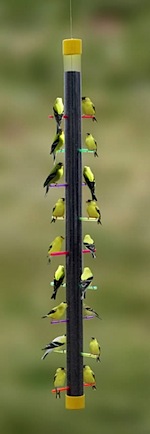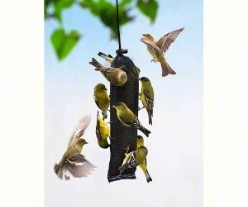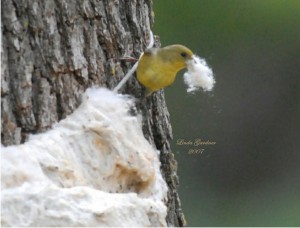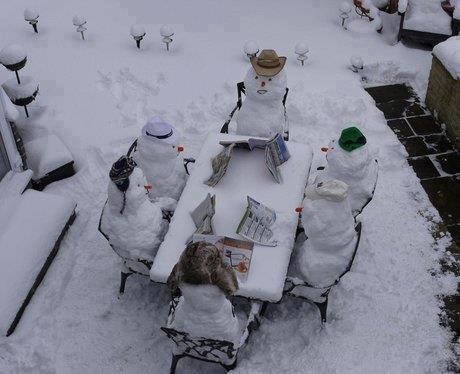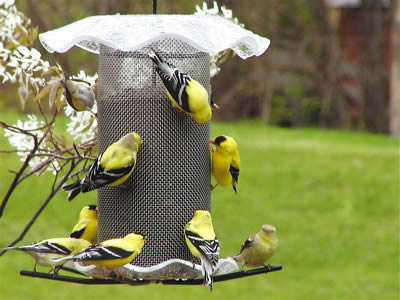-
Nyjer Feeders are Busy Now
They’re the last ones of the season to nest and raise their young, they’re also the only ones who molt twice per year. It really puts goldfinches in a class of their own. It’s the busy season for them, feeding the tiny black seed almost exclusively to babies. During the year, spells of non-activity may be common around nyjer feeders… but not now!
If you offer nyjer or thistle seed year-round, chances are great these birds will stick around. They won’t nest in a birdhouse, but prefer mature trees and shrubs for building their digs. Considered resident birds, in winter you’ll see dull brown-olive plumage, but their sweet song will still grace the garden on the dreariest days. A fresh water source will further entice these friendly fliers.
A fickle seed nyjer can be, it must be fresh for the birds to partake. Should the seed sit in your feeder too long, it may become moldy or rancid and they won’t touch it. One of the benefits of this long tube feeder is the ability to fill it from both ends. By alternating top and bottom refills, there’s no way for older seed to accumulate at the bottom like most feeders.
Another popular style is mesh or screen, offering an all-over feeding space as opposed to individual perches. In recycled plastic, some are durable enough to last a lifetime.
And the last benefit of thistle? It won’t germinate! You’ll never see a nasty weed below these feeders. So fill it up, keep seed fresh, offer a bathing spot and American goldfinches are bound to claim your garden as home sweet home!
-
Thistle Feeders are in High Gear Once Again!
It may be officially summer, but the tail end of spring nesting season is still going strong. Goldfinches are just starting to nest now, which means you’ll be seeing a whole lot of yellow at thistle feeders in the next 2-3 months.
If you’re not offering thistle yet, you may be missing out! The American Goldfinch is a favored backyard songbird as their summer plumage, friendly disposition and sweet song are simply a pleasure to have around the garden. And unlike other birdseed, thistle seed won’t germinate… which is also a pleasure in the garden 🙂
Goldfinches don’t use birdhouses, so there’s no luring them in with that. They’ll raise their broods in mature hedges or trees, constructing nests of woven plant fibers and down. You can encourage them with some nesting materials placed in the vicinity of thistle feeders. They’re partial to Hummer Helper, the hummingbird nesting material, feathers and other fibrous nest offerings.
Unlike some more aggressive birds, goldfinches are quite demure, they’d rather fly off than fight for a spot at the feeder. This where lots of perches, or an all-over feeding space to accommodate them are ideal. Thistle socks are another great choice for goldfinches’ busy time of year. You can easily offer several different feeding spots, without spending a whole lot! Parents will feed babies thistle seed almost exclusively at first, sometimes mixed with finely chopped sunflower bits, you’ll see finches consuming this seed mix too.
As always, fresh water is critical to any bird’s environment. Keeping your bird bath clean is important stuff, for them and for your yard – especially in warm summer weather. Keep water shallow (no more than two inches) and keep it fresh… and they will come!
Oh wait, once goldfinches molt again in September they’ll turn an olive-drab color… but don’t quit feeding them. If you offer thistle year-round, their electric yellow plumage will grace your yard every summer!
-
Can You Spot the Thistle Feeders?
Me neither as they must be covered in snow and awaiting the big thaw. So this is April? Wisconsin, Minnesota, somewhere like that. Goldfinches are already shedding worn winter feathers and turning yellow, while other common resident birds are nesting in much of the country. Once again, will winter ever end?
Yesterday brought our first butterfly to the yard, but unfortunately the consecutive, way below normal night temperature this year zapped established lantana that was seven years old. You could always count on butterflies around those shrubs. Yes, that’s how big they were, mature shrubs.
Erratic weather is largely attributed to climate change, but many folks don’t see it that way. Mudslides, volcanoes, drought and rising sea levels to name a few effects are pretty apparent and scarily becoming the norm.
In the bluebird world, trail monitors found a record number of dead bluebirds in the KY area. A very late spring being the culprit after such a rough winter… there were simply no natural food sources available. Someone was inquiring about a feeder the other day and said “no rush, it’s for next year, we don’t really feed birds in summer”. We’ve come across many folks like that, but here’s the reality: weather directly affects food sources and bird’s survival rates.
Last summer through a wicked drought, we witnessed a male cardinal feeding a fledgeling from a platform feeder containing
sunflower hearts. From ground to platform and back he flew feeding his offspring. It was a strange sight, as others were reported this winter too. Cardinals hanging on suet feeders, and ground-feeding juncos up at black oil feeders. Many of the migratory birds were in for a harsh surprise upon arrival into the gulf states. No flowers, no berries, no insects, simply an equation for starvation after a long journey like that.
Closer to home, resident birds braved a very tough season as well. Feeders were non-stop with activity for the most part. Although thistle feeders didn’t see too much traffic, other feeders containing finch mixes did… and a lot! Once the olive drab fliers began their molting process, straight nyjer became goldfinches’ food of choice and overnight, thistle was and is being devoured daily!
The good news is this seed has come down in price a little bit, and if you can manage the larger bags, like 20-to 40-pounders, you’ll save even more money this summer. Unlike other birds, goldfinches feed nestlings and fledgelings thistle-almost exclusively.
So if you’re not really a “summer feeder”, you may want to rethink maybe just one or two feeders this summer… the bird families sure will thank you!

